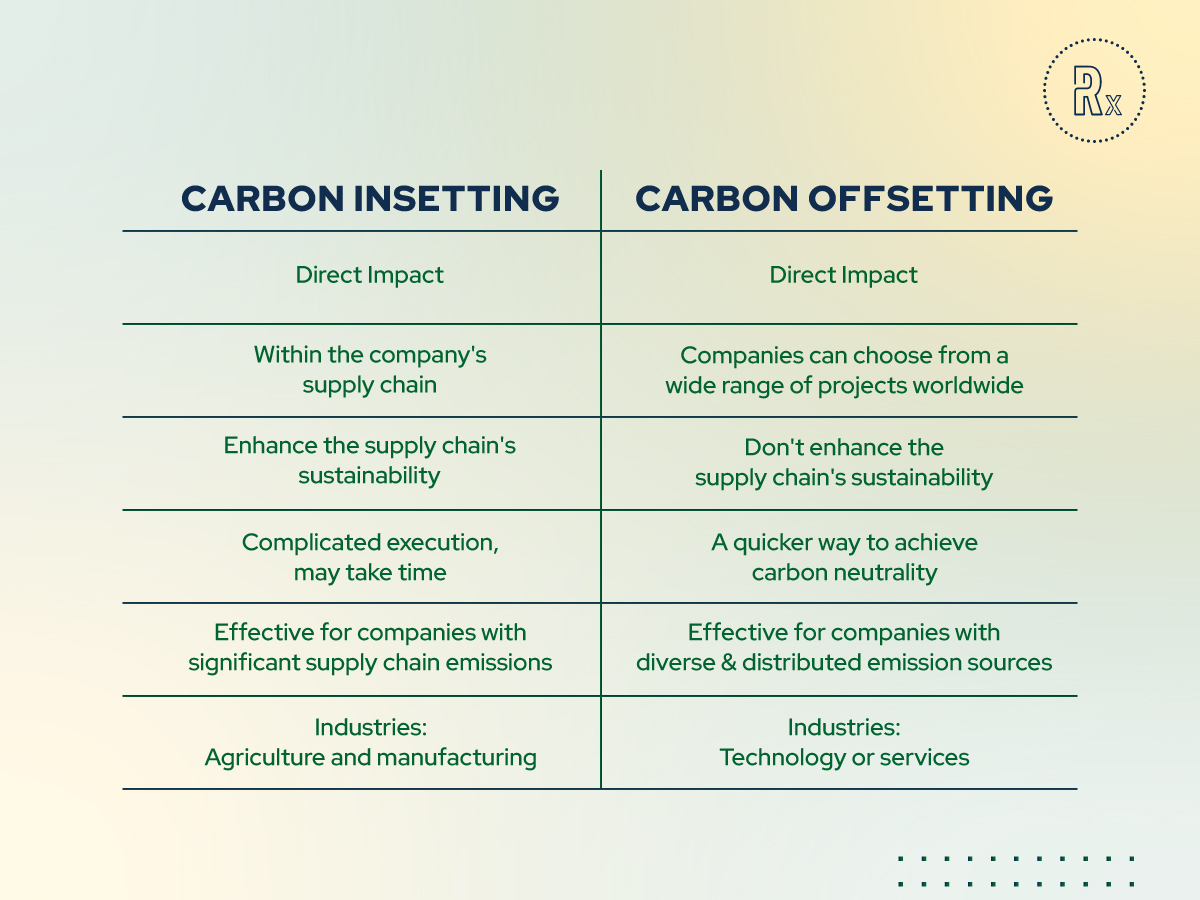In a world increasingly conscious of its carbon footprint, businesses are seeking innovative ways to reduce their environmental impact. While many are familiar with carbon offsetting, there’s a growing interest in a more integrated approach: carbon insetting.
This concept isn’t just a buzzword; it’s a transformative strategy that has the potential to reshape how companies interact with their ecosystems and contribute to a healthier planet.
So,
What is carbon insetting?
Carbon insetting represents a significant shift in how businesses approach their carbon emissions.
Unlike carbon offsetting, which involves investing in external projects to compensate for emissions, insetting is about making changes within a company’s own operations and supply chain. It’s a proactive approach, integrating sustainable practices directly into the core business activities.

The origin of carbon insetting
The concept of carbon insetting emerged as a response to the limitations of traditional offsetting methods. Offsetting often involves external projects, which, while beneficial, can create a disconnect between a company’s direct impact and its mitigation efforts. Insetting, on the other hand, encourages businesses to look inward, identifying opportunities to reduce emissions within their own operations and supply chains.
💡 Read more: Carbon Insetting Examples: How Companies are Reducing Their Emissions Internally
Carbon insetting vs. carbon offsetting
Offsetting typically involves funding external projects like reforestation or renewable energy to counterbalance emissions. In contrast, insetting focuses on internal changes — it could be as simple as improving energy efficiency or as complex as redesigning supply chains to lower emissions.

For a more detailed comparison of these two approaches and to understand their unique roles in climate action, here is a detailed comparison between insetting and offsetting carbon.
Values of carbon insetting
Carbon insetting is not just an environmental initiative; it’s a strategic business choice with a multitude of benefits. Here, we explore the key values of adopting carbon insetting practices.
1. Enhanced brand reputation and customer loyalty
In today’s market, sustainability is not just a trend; it’s a driving factor for consumer choices. Businesses that demonstrate a genuine commitment to environmental stewardship often enjoy enhanced brand reputation.
Carbon insetting is a clear, tangible way to showcase this commitment. By reducing their carbon footprint from within, companies can strengthen their brand image, leading to increased customer loyalty and attracting eco-conscious consumers.
2. Cost savings and operational efficiency
Carbon insetting often leads to more efficient use of resources. For instance, optimizing energy usage or streamlining the supply chain to reduce emissions can also lower operational costs. This dual benefit of environmental responsibility and cost reduction makes carbon insetting a financially attractive strategy for businesses.
3. Positive impact on the community and environment
Carbon insetting projects often have a direct positive impact on local communities and the environment. For example, a company that plants trees as part of its insetting strategy contributes to biodiversity, helps in soil conservation, and enhances the local ecosystem. These projects can also provide employment opportunities and support the livelihoods of local communities.
4. Long-term business sustainability
By investing in carbon insetting, companies are not only addressing current environmental challenges but also preparing for a sustainable future. As regulations around carbon emissions become more stringent, businesses that have already adopted insetting practices will be ahead of the curve, ensuring their long-term viability and success.
5. Compliance with Sustainability Regulations
Carbon insetting enables businesses to meet and often surpass environmental regulations. By integrating sustainability practices internally, companies can avoid non-compliance penalties and adapt to the tightening of sustainability regulation.
This proactive method not only ensures the adherence to current laws but ensure the ease of following future regulatory shifts. More importantly, carbon insetting can facilitate a smoother entry into international markets where environmental compliance is crucial and complex.
How does carbon insetting work in agriculture?
In the agricultural sector, carbon insetting involves implementing practices that directly reduce or capture greenhouse gas emissions within farming operations and supply chains.
- Regenerative agriculture: This approach focuses on rebuilding organic soil matter and restoring degraded soil biodiversity. Techniques like no-till farming, cover cropping, and crop rotation enhance carbon sequestration in the soil, turning farms into carbon sinks.
📌 Example: Regenerative coffee farming with RegenX
RegenX partnered with coffee farmers to promote regenerative agricultural practices. Our venture focused on sourcing finance for the transition to more sustainable farming methods, thus increasing soil carbon storage through methods like shade-grown coffee and organic composting.
The collaboration not only helped reduce the carbon footprint associated with coffee production but also enhanced the quality of the coffee and improved the resilience of farmers against climate change.
- Agroforestry: Integrating trees into farming landscapes is a powerful method of carbon insetting. Trees absorb CO2, and their incorporation into agricultural lands can improve soil health, enhance biodiversity, and provide additional income streams (e.g., from fruit or timber).
📌 Example: Agroforestry in fruit production
An organic fruit producer incorporated agroforestry into their orchards. By planting a diversity of tree species among fruit trees, the company enhanced carbon sequestration on its farms. This practice also increased biodiversity and provided additional crops, demonstrating the economic and environmental benefits of insetting.
- Improved livestock management: Practices like rotational grazing, diet optimization, and better manure management can significantly reduce methane emissions from livestock, a potent greenhouse gas.
📌 Example: Dairy farm methane reduction
A dairy company invested in methane digesters at their supplying farms. These digesters convert cow manure into renewable energy, reducing methane emissions while producing electricity. This initiative effectively insets carbon within the company’s supply chain while also providing clean energy.
- Use of biochar: Applying biochar, a form of charcoal produced from biomass, to soil can enhance soil fertility and lock carbon into the soil for hundreds of years, effectively removing it from the atmosphere.
📌 Example: Biochar usage in crop production
A crop production company began using biochar as a soil amendment across its operations. This practice not only sequestered carbon but also improved soil health, leading to higher yields and reduced reliance on chemical fertilizers.
- Sustainable rice production: Techniques like alternate wetting and drying in rice cultivation can reduce methane emissions, as flooded rice paddies are a major source of this greenhouse gas.
📌 Example: Sustainable rice cultivation
A rice producer adopted sustainable cultivation practices, including alternate wetting and drying. This reduced methane emissions significantly, demonstrating how traditional farming can be modified to reduce its carbon footprint.
7 steps to implement carbon insetting in business
The concept of carbon insetting is not confined to agriculture alone; it’s a versatile approach that can be implemented across various business sectors.
1. Understanding the carbon footprint
The first step in implementing carbon insetting is understanding a company’s carbon footprint. This involves a comprehensive assessment of direct and indirect emissions across all operations. Tools and methodologies from resources like the Greenhouse Gas Protocol guide companies to measure and categorize their emissions accurately.
2. Identifying insetting opportunities
Once the carbon footprint is understood, companies can identify areas within their operations and supply chains where emissions can be reduced or offset internally. This could involve:
- Energy efficiency upgrades: Implementing energy-saving measures in manufacturing or office spaces.
- Sustainable supply chain management: Partnering with suppliers to reduce emissions, for instance, through sustainable raw material sourcing or efficient logistics.
📌 For F&B businesses, particularly in the coffee industry, RegenX provides an investment and sourcing platform for regeneratively produced coffee. We aim to finance sourcing for the regenerative transition, provide higher prices for farmers, improve their livelihood, and retain healthy soil for carbon sequestration.
- Product lifecycle management: Designing products with sustainability in mind, from production to disposal.
3. Setting goals and strategies
With a clear understanding of where changes can be made, companies should set specific, measurable goals for carbon insetting. These goals should align with broader corporate sustainability objectives and possibly global standards like the Science-Based Targets initiative.
4. Engaging stakeholders
Insetting requires the involvement and support of various stakeholders, including employees, suppliers, customers, and investors. Clear communication about the goals and benefits of carbon insetting initiatives is vital. Engaging stakeholders not only garners support but can also lead to collaborative solutions and innovations.
5. Implementing changes and measuring impact
Implementing carbon insetting strategies involves operational changes and potentially a cultural shift within the organization.
Regular monitoring and reporting on progress are essential, using metrics like emissions reduced, energy savings, or increase in sustainable raw material usage. You can also partner with third-party services to handle the number.
6. Continuous improvement and innovation
Carbon insetting should be seen as an ongoing process, with companies continually looking for new ways to reduce and inset emissions. This approach encourages continuous improvement and can drive innovation, leading to new, more sustainable ways of doing business.
A call to action for sustainable business practices
As we continue to navigate the challenges of climate change, it’s clear that innovative approaches like carbon insetting will be pivotal in shaping a more sustainable and resilient business landscape.
By adopting carbon insetting practices, companies can make a significant contribution to environmental conservation, enhance their corporate image, and realize economic benefits.



